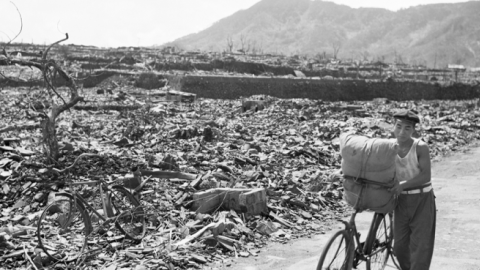p(firstLetter). Seventy-five years ago today, the United States dropped an atomic bomb on Nagasaki, three days after dropping one on Hiroshima. No nuclear weapon has been used by any nation in war since.
The task now is to work to ensure no nation uses them in war again. Our past success should not lead us to naively assume that it will become easier the more time lapses since the events that ended the Second World War; in many ways it will be harder and more complex. Since Hiroshima and Nagasaki, the United States has used nuclear weapons every day—to deter war between the world's major powers. And across administrations, nuclear deterrence has been national security mission one. The result has been relative peace.
The two of us are children of the children of veterans of this great war. One of us is the granddaughter of a maintenance crewman on a B-24 Liberator and the other the grandson of an Army Air Corps pilot—both of whom anticipated their next assignments to be part of the mission to invade the Japanese home islands. Fat Man and Little Boy changed that, and the peace that our grandfathers fought for was secured.
These men knew what historical revisionists from their ivory towers have seen fit to challenge: The use of mankind's most dangerous weapons restored peace and saved countless millions of lives—American and Japanese—in what would have been a necessary invasion of the Japanese home islands.
Times have changed. Allies and adversaries have changed. But mankind's fallen nature has not. Today, unfortunately, we are again necessarily engaged in a new great power rivalry with a corrupt and hostile ideology: the Chinese Communist Party (CCP), with its brand of national socialism.
To wrest the mantle of world leadership from the United States and its allies, General Secretary Xi Jingping and his CCP have set their sights on modernizing their military, including nuclear forces, to become a "first-tier force." In recent years, the People's Republic of China has launched more ballistic missiles for testing and training than the rest of the world combined, and it is now on the cusp of fielding a nuclear triad (i.e., bombers, land-based and submarine-launched ballistic missiles).
And the Russian Federation, while otherwise a failing state in every way, is still investing its increasingly limited resources in fielding a highly capable nuclear force. What's more, according to its recent presidentially ratified nuclear doctrine, Russia is prepared to use nuclear weapons first in a number of highly ambiguous circumstances.
The U.S., while still possessing a robust nuclear force, has barely started on a long-overdue recapitalization of that deterrent force and its support infrastructure. Each of its nuclear weapons, and each associated delivery system, has been in service well beyond its design life.
For decades, the U.S. cut this force as much as it could and delayed needed modernization programs, in the hope that its determination to de-emphasize the role of nuclear weapons in our national defense strategies would be an example to the rest of the world. But merely wanting something to be true does not make it so, and this idealistic gamble failed. While we cut and delayed, our adversaries built, produced and tested, whether in Pyongyang, Tehran, Islamabad, Beijing or Moscow.
It is the paradoxical nature of nuclear deterrence that the surest way to dissuade the use of nuclear weapons in war is to convince America's adversaries that America can, and will, employ them when it is necessary to defend our people, our allies and our way of life.
The U.S. will be able to do that only by ensuring its deterrent remains credible, which means adversaries believe the cost of their aggression would be unacceptably high. And we know how to maintain our nuclear deterrent; there's a bipartisan plan across two administrations about how to do it.
The Obama and Trump administrations issued similar roadmaps (the 2010 and 2018 Nuclear Posture Reviews) to recapitalize the U.S. nuclear deterrent. The Obama administration chose to eschew a No First Use (NFU) policy, believing, rightly, that such a pleasant-sounding policy could unintentionally invite aggression. Inexplicably, former Vice President Joe Biden has recently voiced his support for NFU—at almost the same time that Russian President Vladimir Putin introduced his diametrically opposed nuclear use policy.
Descendants of the Greatest Generation understand that every decision made related to the U.S. nuclear deterrent, whether in adaptations to the force, allowing the force to atrophy or investing in it, declaratory statements, and entering into or staying in or leaving treaties and agreements, must be considered in light of the ultimate goal of maintaining the unprecedented success of 75 years without large-scale war and against nuclear use in war.
It is remarkable to consider that after the most devastating war humanity has ever fought—some 60 million dead—our two defeated adversaries are now two of our closest allies. In only two generations since our grandfathers were preparing to invade the Japanese home islands, Japan has become an indispensable ally in a new global struggle against national socialism.
We owe so much to the efforts of our forebearers. The current generation of Americans would do well to study our history and, with gratitude, work to defend what we have inherited.



















